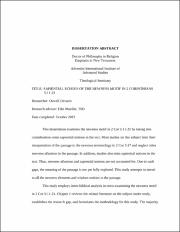Sapiential echoes of the newness motif in 2 Corinthians 5:11-21
Abstract
This dissertation examines the newness motif in 2 Cor 5:11-21 by taking into consideration some sapiential notions in the text. Most studies on this subject limit their interpretation of the passage to the newness terminology in 2 Cor 5:17 and neglect other newness allusions in the passage. In addition, studies also miss sapiential notions in the text. Thus, newness allusions and sapiential notions are not accounted for. Due to such gaps, the meaning of the passage is not yet fully explored. This study attempts to attend to all the newness elements and wisdom notions in the passage.
This study employs inner-biblical analysis in cross-examining the newness motif in 2 Cor 5:11-21. Chapter 1 reviews the related literature on the subject under study, establishes the research gap, and formulates the methodology for this study. The majority
of scholarship understand the newness motif in 2 Cor 5:11-21 along three views: (a) new anthropology, (b) new cosmology, and (c) new exodus. Chapter 2 traces the conceptual background of the sapiential newness in 2 Cor 5:11-21. It establishes that OT wisdom thinking as reflected in the Wisdom Literature and some apocalyptic texts form the fundamental backdrop of Paul’s newness motif. Chapter 3 presents an inner-biblical analysis of the sapiential newness in 2 Cor 5:11-21. Chapter 4 presents some theological implications of the sapiential newness motif. It also presents a summary and conclusion of the study.
This study offers a unique understanding of 2 Cor 5:11-21 that better reflects Paul’s usage of sapiential notions to convey the newness motif. Such approach is more consistent with the paraenetic style of writing that Paul utilized in most of his writings. The study discovers that the newness motif in 2 Cor 5:11-21 is Christ-centered. In the Corinthian Epistles, Christ is wisdom personified. In that capacity, Christ is the agent of new creation as also reflected in Prov 8:22-31. He is also the agent of reconciliation and righteousness as reflected in Isa 11:1-10. Thus, the new creation in 2 Cor 5:17 denotes renewed mindset that lead believers to reflect Christlikeness in all conduct.


